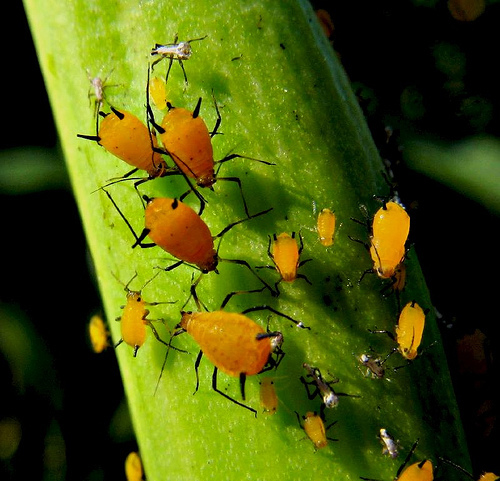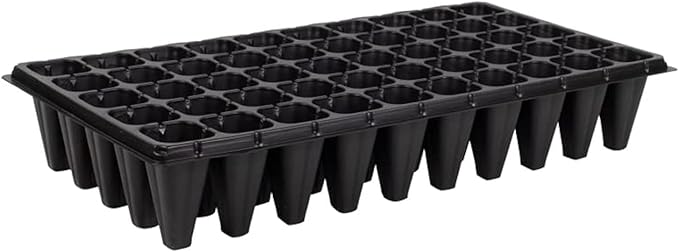
Aphids are those little pear-shaped gals that congregate around the undersides of leaves or the terminal buds on your rose bushes. You won’t be bothered by them in numbers of two or three, but when the situation resembles a Rolling Stones concert – that’s when you’ll sit up and take notice.
Another flag that may alert you to these ladies’ presence is a long ant trail, which much like groupies, seem to worship the ground the aphids walk on. The reality is that while the aphids suck the life out the tender greens on your plants, they are secreting a sticky-sweet substance called “honeydew” that the ants find quite irresistible. Hence, their tireless pilgrimage up and down every plant that may host an aphid.
Aphids come in a wide variety of sizes, shapes, and colors. They can be green, red, black, yellow, or brown. They don’t have much of a discriminating palate, though – they’ll attack various vegetables, legumes, stone fruit crops, roses, apples, and ornamentals.
Fortunately, in moderate amounts aphids do minimal damage to plants. They’re certainly unsightly and in massive amounts, they’ve been known to suck the life-blood (sugars) out of plants or distort flower buds or foliage. One of the ways a few aphids becomes an overwhelming mob of aphids is with the help of their devoted followers, the ants.
The ants become so punch-drunk with the honeydew that to ensure a steady supply of the nectar, they begin to protect the aphids from the aphid’s natural predators. These include parasitic wasps, lady beetles, lacewings, syrphid fly larva, and leatherwings. So, one of the best ways to control aphids in the garden is to take out the body guards.
Aphid Reproduction
The other reason a bazillion aphids seem to be born overnight is because they are – literally. Here’s the thing, aphids are all women. Every lady aphid is born pregnant. You just have to wonder what they did so wrong to deserve that. While they are born pregnant, they don’t actually give birth until they are a mature adult – which is about ten days after their own birth.
In the warm temperatures of spring, out of the over-wintering eggs emerge the female aphids called “stem mothers”. The stem mothers give birth to live daughters, who are also pregnant. No candlelight or jewelry necessary. In other words – they don’t need no stinking man. It’s really a superior race of women gone terribly wrong.
This odd phenomenon continues with every generation of girl aphid until the end of the season. This is where it gets interesting. At this point, the aphids begin to produce daughters and sons. These sons mate with the current generation of female aphids and those females lay eggs on bud scales to over-winter. Thus, the freaky cycle begins again.
Non-Toxic Aphid Controls
1. One of the best ways to control just about any pest in the garden is to be able to recognize the good guys, the cavalry, Indiana Jones. Learn your beneficial insects like the parasitic wasps (they can’t sting people). These dudes go through the abdomen of the aphid and lay their eggs inside. When the wasp larva is born, they emerge from the aphid’s belly. Okay, gross but effective.
Look at pictures of lacewings, leatherwings, and baby ladybugs. I promise, you won’t recognize a baby lady bug. They resemble red and black alligator (seriously). One ladybug will eat 5,000 aphids in its lifetime.
2. Plant flowers that attract beneficial insects to your garden. The adult forms of many beneficials feed on the pollen of these plants – so have a wide variety available. There are also online sources for purchasing beneficial insects for your garden.
3. You can always wipe off or prune away the leaves and buds to clear out colonies of aphids.
4. Using a forceful stream of plain water does the trick incredibly well. The aphids are knocked off the plant and usually end up breaking their jaw when they hit the ground (I don’t make this stuff up). Aphids are very slow movers, so even if they did manage to get back up the plant, they can’t very well eat with a dislocated jaw.
5. Try controlling their henchmen, the ants. Try Tanglefoot or Stickem around shrubs or trees.
6. If it just makes you feel better to “use” something, try an insecticidal soap. It kills aphids on contact, but doesn’t leave any toxic residues that could harm the beneficial insects. Insecticidal soaps are suppose to be safe for food crops, but if you want to be 100% sure try a mix of 1-3 teaspoons of household soap (not detergent) per gallon of water.
Fine Gardening Recommended Products

Nothers RooTrimmer 50 Cell, 10pcs
Fine Gardening receives a commission for items purchased through links on this site, including Amazon Associates and other affiliate advertising programs.

Corona High Performance Orchard Loppers
Fine Gardening receives a commission for items purchased through links on this site, including Amazon Associates and other affiliate advertising programs.

ARS Telescoping Long Reach Pruner
Fine Gardening receives a commission for items purchased through links on this site, including Amazon Associates and other affiliate advertising programs.



















Comments
Log in or create an account to post a comment.
Sign up Log in